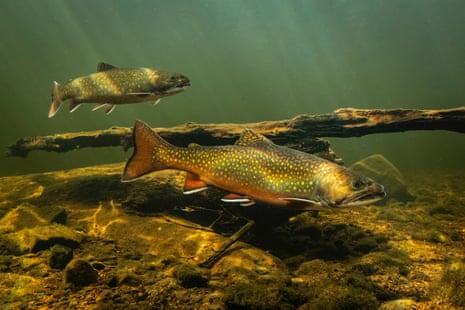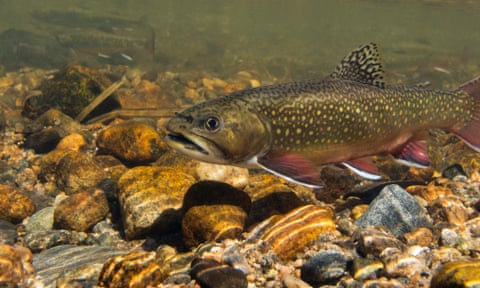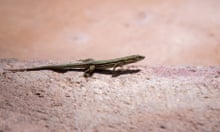On a golden morning in early October, two graduate students from New Mexico State University plunge into the icy current of Leandro Creek. The small waterway flows through the 550,000 acre Vermejo park ranch, a reserve in the Sangre de Cristo Mountains, and the pair are in search of an unusual fish.
Kelsie Field, 25, from the Department of Wildlife and Conservation Ecology, wears a pair of worn grey waders and carries two eight-gallon buckets, one full of water, the other, of scientific gear: test tubes, an electronic scanner and surgical implements. Michael Miller, 30, shoulders a large, waterproof backpack containing a battery attached to an electrode that resembles a metal detector.

Researchers Kelsie Field and Michael Miller go ‘electrofishing’ in New Mexico. Photograph: Jeremy Miller
Miller dips the “detector” into the creek, squeezing the handle to send approximately 300 volts through the water. While the team’s rubber boots insulate them from the shock, the resident fish are stunned and drift to the surface just long enough for Miller to net them and deposit them in the bucket. Most measure about 10 inches, though some are no larger than a little finger and a few stretch to 16 inches or more.
There are just two species here. One is an embattled native, the Rio Grande cutthroat trout (Oncorhynchus clarki virginalis), distinguished by its cream-coloured skin, mottling of black spots and a vibrant orange slash under the jaw. Once widely distributed in rivers and streams across northern New Mexico and southern Colorado, it is now found across just 10% of its historical range. Today, it is reeling under the pressures of the climate crisis, habitat loss and – in the case of Leandro Creek – a hardy intruder.

Miller checks in with other team members at Vermejo park ranch. Photograph: Jeremy Miller
The more prolific species writhing in Miller’s net is the brook trout (Salvelinus fontinalis). The smaller “brookies” are sleek and silvery, while the adults sport a riot of red and blue spots on their sides, and an orange belly.
How this beautiful interloper from eastern North America got here is unclear, beyond that it was part of a human-aided diaspora that released brook trout into high-altitude lakes and creeks across the west. The brookies’ voracious appetites and rapid sexual maturation have spelled trouble not only for native trout such as bull, rainbow, California golden, and cutthroat, which they out-compete, but also for a host of other aquatic organisms, including frogs and salamanders.

Brook trout have voracious appetites and rapid sexual maturation, giving them the edge over other species. Photograph: Nick Hawkins/NPL
Brook trout may greatly outnumber the Rio Grande cutthroat here, but nearly every brookie the team captures is male. That’s because many are a lab-produced variety known as “Trojan” brook trout. They are unique in that they carry not one, but two copies of the Y chromosome that codes maleness; they have no X chromosome to pass on. Since 2018, various streams across the Vermejo reserve have been stocked with this strain in an attempt to tilt the brook trout sex ratio so far male that eventually the population will stop breeding and die out on its own. Similar efforts are under way in a handful of creeks in Idaho, Washington and Oregon, and Nevada plans to embark on its own stocking programme this summer.
Until now, the main tool to eliminate invasive fish species has been the potent chemical rotenone. The trouble is that “it also kills all the other fish, including the ones you are trying to conserve,” says Colleen Caldwell, a professor of fish and wildlife at New Mexico State University and a principal investigator overseeing the Leandro Creek project.
Researchers are still trying to understand if Trojan trout behave enough like wild male trout to convince females to breed with them, as well as whether they can thrive enough in their new environment to tip the scales in the Rio Grande cutthroats’ favour. But the hope is that the imposters will excise brookies from stream systems, without the need to bomb them with an indiscriminate chemical agent.

Michael Miller shows a Rio Grande cutthroat caught from the stream. Photograph: Jeremy Miller
Despite the method’s promise, it raises questions about ethics and unforeseen outcomes. “No matter what people say, the long-term effects of these things are just unknown,” says Marc Bekoff, an emeritus biology professor at the University of Colorado-Boulder and a prominent behavioural biologist. “Their goals might seem laudable today, but with rapidly reproducing organisms, you might not even know what’s going to happen in half a year.”

An invasive species
Clear streams are surrounded by lush vegetation in the mountains of northern New Mexico. Photograph: Christina Selby
Brook trout are, in some ways, a good problem to have. They live only in clean, cold water (Salvelinus fontinalis means “living in springs”), so their presence indicates a waterway untainted by pollution. Twenty thousand years ago, at the height of the Pleistocene, they were confined to waterways at the margins of glaciers, which extended deep into the interior of North America. As the glaciers ebbed, the species spread throughout the Appalachians, Great Lakes and deep into the Canadian interior. The Mississippi River stopped their spread farther west because it was too warm for them.
It was newly arrived Europeans who helped them cross that barrier – and in large numbers. Settlers planted brook trout in streams and lakes in the Rockies, Cascades and Sierra Nevada. The railways sped its westward migration, with specially designed “fish cars” filled with eastern species, including striped bass, brown trout and brook trout.
“Acclimatisation”, in vogue in the late 19th century, also accelerated the process, with adherents believing that introduced species improved ecological conditions.

Trampas Lakes in New Mexico’s Pecos Wilderness is an ideal environment for both brook and cutthroat trout. Photograph: Christina Selby
As a destructive force, the brook trout is in good company. In the US, 42% of endangered species have been “significantly impacted” by invasive species, according to the Environmental Protection Agency. Among aquatic species, the numbers are starker, with invasives implicated in 70% of extinctions.
Shifting the sex ratio
The Trojan brook trout that inhabit Leandro Creek were made at the Hayspur Fish Hatchery, near Sun Valley, Idaho. The programme was started in 2008 at a different Idaho hatchery by Dan Schill, a now-retired fish biologist from the Idaho Department of Fish and Game, after hearing a presenter at a conference mention something called the “Trojan Y chromosome approach”. “It was all a theoretical thing,” he recalls. “But it said if you could create a YY broodstock of an invasive fish and put it on the landscape then, in theory, you could shift the sex ratio to all males.”


Fish culturist Tom Lindenmuth oversees operations at the Hayspur hatchery in Idaho as trays of eggs await shipping across the country. Photographs: Jeremy Miller
In the incubation building at the hatchery, inside dozens of blue cyndrical tanks, are “larval” male brook trout, which look like tiny brine shrimp with their egg sacs still attached. Once the sacs have been absorbed and the fish are ready to feed, attendants give them food coated with estradiol, a form of the female hormone oestrogen. Over a two-month period, the estradiol turns their sperm-producing testes into ovaries, and the genetically male fish become capable of laying eggs.
When hatchery workers breed these fish with normal XY males, 25% of their offspring will be female with two X chromosomes, approximately 50% will be typical males with an X and Y chromosome, but 25% will be the special variety key to the genetic population control scheme: males with two Y chromosomes. Some of the YYs will be given estradiol, causing them to form ovaries and produce eggs. These “feminised” YY fish are then crossed with YY males to create the hatchery’s broodstock. The other YYs will be transplanted into streams. If and when these “super-male” brook trout fertilise the eggs of wild female brook trout, they will produce 100% male offspring.
Opposite the rearing vats are several rows of incubation cabinets filled with small trays containing hundreds of brook trout eggs laid by a single feminised YY male. Tom Lindenmuth, a fish culturist and manager who oversees the operation, explains that the eggs will be treated with Ovadine, a chemical that strengthens their shells for shipping. Then they will be packed in wet paper towels and ice and mailed to hatcheries in Washington, Oregon, Nevada and New Mexico.

Tom Lindenmuth scoops up a handful of brook trout eggs at the hatchery. Photograph: Jeremy Miller
To keep estradiol from leaching into surrounding waterways and causing a similar sex transformation in wild fish, the hatchery uses a sophisticated water recycling system. And because the fish directly exposed to estradiol never leave the hatchery, Lindenmuth explains, there is no danger that they will dose waterways, or fishers who might catch and eat them, with a concentrated dose of hormones.
Back at the Vermejo reserve, well over half the fish the team have counted so far are of the Trojan variety. Field makes a quick swipe of one of the fish with a scanner, which returns a beep. This indicates that the fish contains a PIT tag, no larger than a grain of rice, which contains information such as where and when the fish was hatched and when it was released. Miller inspects the fish quickly, sliding thumb and index finger along its underbelly, which produces a spurt of milt, a milky substance containing sperm. He notes the missing adipose fin, clipped by workers at another hatchery months earlier – another clear sign that this is a Trojan.




Back in New Mexico, researchers Michael Miller and Kelsie Field set about the complex tasks that will gauge the success of the project. Photographs: Jeremy Miller
By the end of the second spawning season, in 2020, 75% of the fish captured in Leandro Creek were male, and almost 30% of the juveniles from test streams around Vermejo were the male offspring of YY brook trout. Miller hopes this year’s percentages will be higher.
‘It’s not a radical departure’
The debate around genetically modified organisms, or GMOs, and their potential to harm native species is a heated one. But while there is little doubt that scientists have reshuffled the Trojan trout’s existing chromosomes, they haven’t inserted any foreign genes into their DNA, says Schill. That makes them different from a GMO and so-called “frankenfish”.
Chemically altering an organism in pursuit of a conservation goal “is not a radical departure from the kinds of things that conservationists are generally trying to do”, says Ron Sandler, a professor of philosophy at Northeastern University who specialises in bioethics. And it’s much less radical than “assisted evolution”, where novel genes are inserted to make creatures better suited to cope with human-altered environments.

Some biologists question the ethics of releasing genetically modified, lab-produced trout into the wild. Photograph: Jeremy Miller
Bekoff argues, however, that the approach being taken with the Trojan trout treats the significant alteration and potential suffering of animals too blithely. “If someone said to me: ‘We’re going to turn you from a male to a female’, I’d say: ‘I don’t want to be.’” Bekoff, who advocates for a humane approach called “compassionate conservation”, praises the effort to find a nonlethal means to control brook trout populations, but says that scientists often forsake the lives of individual organisms for the perceived needs of populations and ecosystems.
There may be unforeseen consequences from using rapidly reproducing, modified non-native animals as a form of biological control, adds Bekoff. “You could produce a nightmare very quickly,” he says.
Take, for example, the cane toad (Rhinella marina) brought from Central and South America to Australia in 1935 to help with native beetles that were ravaging the country’s sugarcane fields. The toads devoured or poisoned the continent’s endemic lizards, snakes, and birds in massive numbers. Today, Australia’s population of cane toads is estimated at 200 million despite numerous efforts at eradication.

Trojan brook trout, like this one reared at the Idaho hatchery, may be the best hope for native trout species. Photograph: Jeremy Miller
Schill dismisses the possibility of such a disaster at Vermejo. Unlike the toads, brook trout have already colonised the streams into which the new strain is being introduced. Moreover, those streams have barriers – some natural and others human-made – that prevent their movement out of the study area. And since brook trout and cutthroat trout are genetically incompatible and can’t breed with one another, there is no risk of creating hybrids.
However, some biologists do worry about YY brook trout released into Idaho streams that contain native bull trout. The bull trout, Salvelinus confluentus, is closely related to brook trout and the two can produce hybrid offspring.
‘We can fix our mistakes’
By the time Miller and Field finish their work at Leandro Creek, a pattern has emerged: the Trojan brookies appear to be thriving and the cutthroat, though fewer in number, are holding their own.
Given enough time – anywhere between five and 15 years, if predictions hold – brook trout reproduction could cease, and Rio Grande cutthroat populations could reclaim their stream, says Miller. “Some waterways have been modified beyond any hope of repair. But in other places, we have the ability to fix our mistakes,” he says.
“We have an ethical responsibility to do what we can, where we can, to restore that natural history.”

The colours and patterns typical of a male brook trout. Photograph: Nick Hawkins/NPL
A longer version of this story was originally published in bioGraphic, an independent magazine about nature and conservation powered by the California Academy of Sciences.





